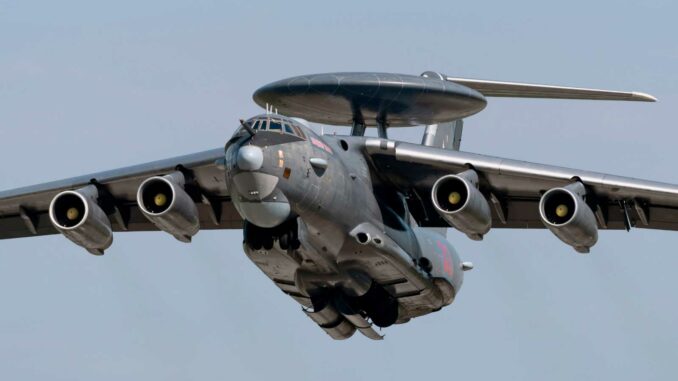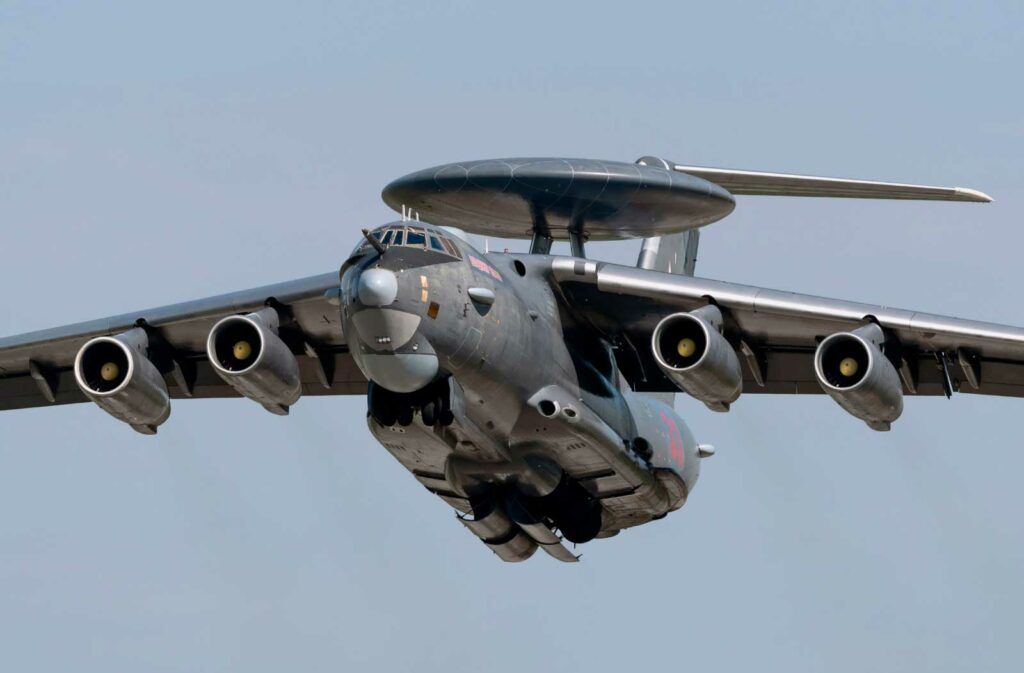
An A-50U spotted in Taganrog, 170 km from the front line: a rare and crucial asset for surveillance, but now within range of Ukrainian strikes.
Summary
A Russian A-50U—a long-range detection and air operations control aircraft—has been observed at the Taganrog base, approximately 170 km from the front line. This aircraft, of which very few fully operational examples remain, is central to Russian air defense: it detects Ukrainian aircraft, missiles, and drones at great distances and guides interceptors and surface-to-air batteries. But Taganrog has already been targeted by drones and missiles. The presence of a Russian AWACS so close to the front line increases the likelihood of an attack on an asset that is virtually irreplaceable. Since 2023-2024, Ukraine has damaged or shot down several A-50Us (including one over the Sea of Azov), reducing Russian radar coverage. An additional loss would further limit rotations, complicate surveillance of southern Ukraine and Crimea, and facilitate breakthroughs by long-range missiles and drones.
The placement of the A-50U in Taganrog: a tactical gain under serious threat
An A-50U identified as RF-94268 (“Red 41”) was spotted between September 24 and 28 at the Taganrog base, home to the Beriev factory responsible for upgrades and maintenance. This base is located approximately 170 km from the front line, within range of many Ukrainian vectors: long-endurance kamikaze UAVs, air-launched and ground-launched cruise missiles. Open source images and analyses show that Taganrog has already been targeted several times, particularly against hangars linked to the A-50/A-50U programs, confirming the vulnerability of the site. For Moscow, bringing the aircraft closer improves detection geometry over southern Ukraine and the neighboring Russian territory. But this gain comes at a high risk: on the ground, the aircraft is exposed, and in flight, its radar profile and operational value make it a priority target. With an estimated catalog cost of around $330 million—approximately €307 million at current rates—the loss of such a system cannot be quickly replaced in an industrial context under pressure and subject to sanctions. The decision to deploy it so close to the front line reflects an urgent need to restore a detection and coordination bubble, even if it means accepting an unfavorable risk/reward ratio in the event of a successful strike against the aircraft or its support infrastructure.
The reduced A-50U fleet: confirmed losses and a restricted deployment tempo
Since February 2023, the A-50/A-50U have become prime targets. One aircraft was damaged in Machulishchy (Belarus) during an attack claimed by the Belarusian opposition; Minsk acknowledged the incident and sent the aircraft back to Russia for repairs. On January 14, 2024, an A-50U was shot down over the Sea of Azov; open sources and Western officials reported the use of a Patriot system. On February 23, 2024, a second A-50U was reportedly destroyed in the same area, this time by an S-200 system brought back into service by Ukraine. In addition to these losses, Ukraine has carried out operations against bases and facilities linked to A-50 support, including damage observed in March 2024 to hangars in Taganrog and coordinated strikes in June 2025 (Operation Spider/Cobweb) that may have hit additional aircraft. In total, several sources estimate that the fleet that is actually “airworthy” has shrunk to a handful of aircraft, forcing Moscow to disperse and conserve these platforms, sometimes as far away as northern or far eastern Russia. Under these conditions, maintaining quasi-permanent coverage requires at least three aircraft (one on patrol, one on standby, and one in maintenance/rest), which becomes difficult with a reduced fleet. Each sortie mechanically wears down the airframe/radar resources and increases logistical pressure (crews, parts, Shmel-M antennas), hence the advantage of short rotations close to the front line… which paradoxically increase exposure to strikes.
The technical capabilities of the A-50U: an airborne radar at the heart of air defense
The A-50U is a major evolution of the Il-76 airframe with avionics modernization, cabin ergonomics and, above all, an upgrade of the Shmel-M radar complex. The publicly available detection ranges vary depending on the size/altitude of the target and the angle of illumination: up to 300 to 400 km for a fighter-type aircraft, and even further for larger aircraft. the detection of energetic events (missile launches) and weapons with low radar cross-sections remains possible at long distances, at the cost of constraints on signal processing and track kinematics. Ukrainian sources mention the ability to detect missile and attack glider signatures at ranges of up to approximately 600 km; In all cases, the military value of the system lies as much in detection as in data fusion/correlation and its function as an “airborne controller” for interceptors and long-range surface-to-air systems (S-300/400), with data links and engagement priority management. The typical configuration carries up to fifteen mission personnel (radar operators, electronic warfare, control). In terms of energy, the radar requires significant power consumption and thermal management, which limits the duration of the station, generally in the order of a few hours per cycle before refueling or relief. This architecture offers a clear advantage: anticipating ATACMS, Storm Shadow/SCALP-EG, JDAM-ER, and penetrating Ukrainian drone trajectories. But it has flaws: saturation by multi-axis attacks, low RCS targets in low-level flight, jamming/decoys, and dependence on known fixed bases.

The consequences of an additional loss: Crimea and southern Russia more vulnerable
If Ukraine were to succeed in destroying the A-50U based in Taganrog, the effect would go beyond a simple arithmetic reduction in the fleet. First, surveillance coverage of the Azov Sea axis – the Krasnodar coastline – and access routes to Crimea would be less dense, especially during relief slots. The windows of opportunity for salvos combining low-cost drones, long-range missiles, and decoys would increase, which would facilitate the penetration of S-300/400 layers when they are not precisely “guided” by a Russian AWACS. Then, the constraint of preserving surviving aircraft would push Moscow to extend patrol routes (less effective) or to retreat orbits (loss of range on low targets). In the short term, this would result in more successful strikes against depots, radars, naval sites, and logistics bridges, particularly on the Black Sea coast and at airfields in the south. In the medium term, the depletion of the fleet would require trade-offs: prioritizing the protection of strategic bombers (Tu-95/Tu-22M3) during firing campaigns, to the detriment of “general” air surveillance. The operations of June 2025 have already shown that a well-planned drone campaign can damage a significant portion of the air force based far from the front; the psychological effect and the overload on technical teams add to the wear and tear on the surviving aircraft. In this context, one less A-50U would amplify a vicious circle: fewer airborne sensors, greater consumption of ground-based radars, and more opportunities for Ukrainian deep strikes.
The Russian response: the A-100 option, dispersion, and industrial limitations
On the Russian side, there are three levers: reviving the pace of A-50→A-50U retrofitting, accelerating the A-100, and dispersing assets. Retrofitting is slowed down by the availability of radar and electronic assemblies. The A-100 “Premier” is progressing in trials but remains at the prototype stage; its entry into operational service has been repeatedly postponed due to technological sanctions (electronic components) and budgetary priorities. Even if the VKS received pre-production aircraft, it would take years for the units to absorb them, train crews, and increase availability. The dispersal of the A-50Us to the north and east reduces exposure… but also reduces the quality of coverage over the south if the orbits move further away. As for the bases near Ukraine, they must be hardened: camouflage nets, hardened shelters, MANTIS anti-drone systems, and multi-layered firing echelons. However, Taganrog has already suffered damage to its hangars, meaning that the enemy is familiar with the topography and approach corridors. In short, Russia can limit the risk, but not eliminate it, as long as Ukraine retains its long-range strike capabilities and a continuous flow of low-cost attack UAVs.
Strategic issues: a critical asset in the face of attrition
Beyond tactics, the presence of an A-50U in Taganrog illustrates a structural tension: the VKS needs airborne eyes to compensate for the blind spots of ground-based radars, but it no longer has sufficient reserves to absorb losses. Ukraine, for its part, is pursuing a strategy of attrition: degrading Russia’s few strategic sensors in order to open corridors for Ukrainian drones and missiles. The cost/effect balance is asymmetrical: a UAV costing a few tens of thousands of euros can immobilize, or even destroy, an asset worth several hundred million, not to mention the value of trained specialists. In this equation, the argument for stationing a Russian AWACS closer to the front line to “see better” comes up against a simple fact: closer means more vulnerable. As long as the close-range anti-drone defense of Russian bases remains imperfect and the orbits remain identifiable, the risk of neutralization will persist. For the reader, the key point to remember is stark: at the current rate, each A-50U lost creates a capability deficit that Russia cannot quickly fill, and each repair/return-to-service cycle consumes industrial capital that is already under pressure.
War Wings Daily is an independant magazine.